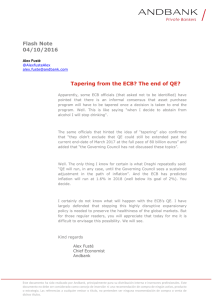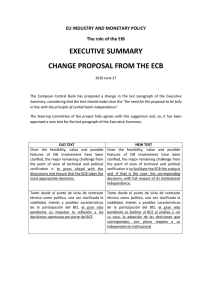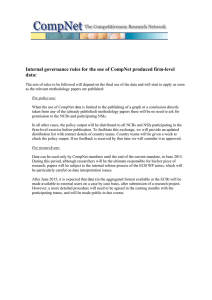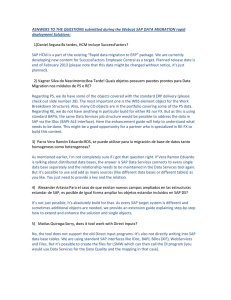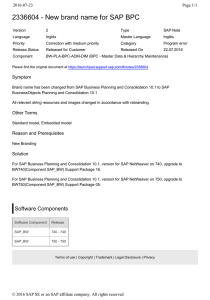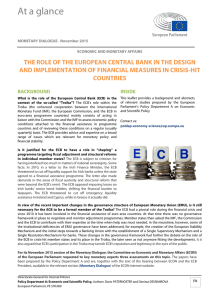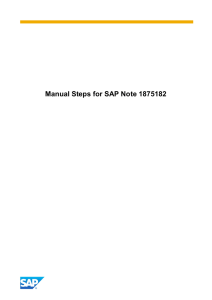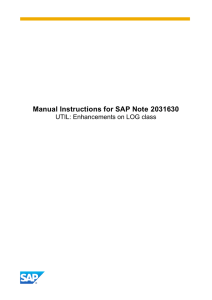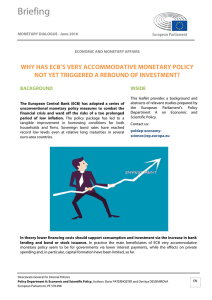Harmonization of Balance of Payments Reporting by Multinationals
Anuncio
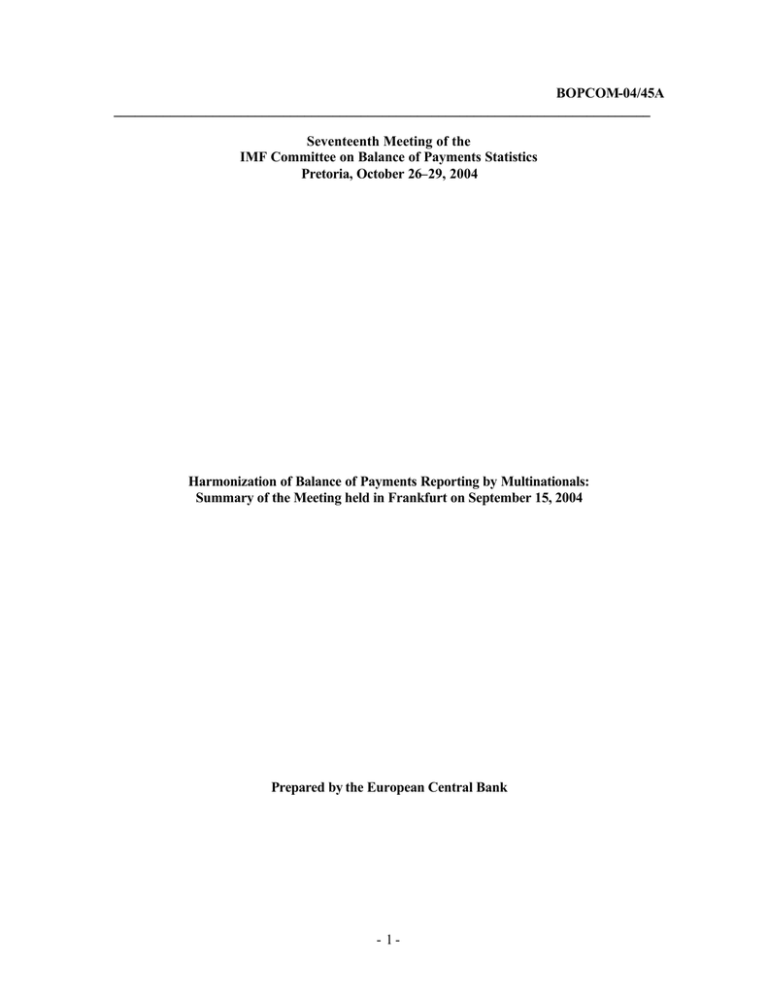
BOPCOM-04/45A ____________________________________________________________________________ Seventeenth Meeting of the IMF Committee on Balance of Payments Statistics Pretoria, October 26–29, 2004 Harmonization of Balance of Payments Reporting by Multinationals: Summary of the Meeting held in Frankfurt on September 15, 2004 Prepared by the European Central Bank - 1- EUROPEAN COMMISSION EUROPEAN CENTRAL BANK EUROSTAT DIRECTORATE GENERAL STATISTICS HARMONISATION OF BALANCE OF PAYMENTS REPORTING BY MULTINATIONALS Summary of the meeting held in Frankfurt, on 15 September 20041 Mr. Israël introduced the discussion by a short presentation of the overall project initiated by the letter dated June 2000 of the then Chairman of the European Round Table of Industrialists, Mr. Tabaksblat, to the President of the ECB, Mr. Duisenberg. The ECB and the European Commission (Eurostat) mandated the Steering Group on Multinationals (SGM), chaired by Marius van Nieuwkerk from De Nederlandsche 2 Bank , to assess the feasibility of a harmonised reporting form for multinationals across the EU. This meeting will present the outcome of the whole exercise and the discussion will focus on the possible follow-up and implementation, if considered appropriate. Upon a question from Mr. Ibars (Nestlé) on possible developments in Switzerland or elsewhere outside the EU, Mr. Israël mentioned that, though the approach focused on the EU, contacts were taken with statisticians in other countries. The Swiss National Bank in particular is represented in some Working Groups and held informed on this issue. 1. Findings of the feasibility study and data test of implementing a standard reporting for multinationals Mr. Hofman (Secretary of the SGM) presented the outcome of the feasibility study and of the data testing. The reporting forms had been elaborated by Eurostat’s Technical Group on Direct Reporting, and conform with international statistical standards. The forms are composed of two sections: services and financial assets/liabilities (all cross-border). These forms would be reported directly to national statistics compilers. The feasibility study and the testing aimed at verifying the extent to which information could be made available in an automated way from the bookkeeping of the companies, in particular accounting ledgers 1 2 The list of participants is given in annex. Mr Marius van Nieuwkerk was excused. - 2- or other systems used for financial transactions. In this aspect, IT products may bring down reporting costs of companies. 3 The SGM visited 16 companies between November 2001 and November 2003. From those, all 16 were involved in the feasibility questionnaire and 12 filled in the reporting forms. Non-response was mainly due to commercial reasons. The main findings can be summarised as follows: • The major advantage of standardisation is related to the expected gains in efficiency. However, not all information required by proposed model was directly available; initial IT investment was often considered necessary. Hence, ERP-embedded solutions are strongly supported. • Most relevant items to be reported are services, outward foreign direct investment, loans and borrowings (often inter company). • Balance of payments (b.o.p.)/international investment position (i.i.p.) compilers would need to prepare their systems in order to deal with the harmonised reporting format for multinationals aside 4 their current, or revised, national reporting format (for all other reporting agents). • Benefits for companies are estimated to be higher when the headquarters are able to report on behalf of subsidiaries in all countries 2. Comments by corporate participants on the outcome of the feasibility study and data testing The representatives of the four multinationals represented commented on the outcome of the feasibility study and data testing. Mr. Hernandez Piney (Repsol) informed that his company had recently undergone the integration of the accounting software within the group. As advantages of the harmonised reporting, he referred to the improvement of the overall consistency and quality. On the other hand, he would favour an implementation of the harmonised reporting after his company finalises work related to the International Accounting Standards (IAS). Mr. Zangs presented an overview of the situation at Thyssen Krupp as regards balance of payments reporting. The company applies quarterly centralised accounting. This system does not focus on all details of financial assets and liabilities data which would be needed for the harmonised report. More detailed (and monthly) information is in principle available in the individual companies. Delivery of 3 4 14 industrial multinationals, 2 companies in the service sector. The cost for national statistics compilers is, thus, also important. However, they may be ready to proceed if there are significant benefits for multinationals in reducing the reporting burden. In addition, this approach may assist in enhancing data quality, though other approaches may also contribute to such an outcome. - 3- information according to the harmonised model would require adaptation of the (consolidation) software used. Therefore, Mr Zangs considered that Thyssen Krupp may not yet be in a position to yield all benefits from the harmonised reporting model. Mr. Caillol mentioned that Solvay was already running a centralised system of invoicing for most, and possibly soon all, companies of the group. Currently, the b.o.p./i.i.p. reports for countries where the group is established are already run from the headquarters in most cases. Mr Caillol noted the different requirements in countries and claimed for a standard approach by statistical authorities. Mr. Ibars indicated that Nestlé had already centralised information about financial positions, though payments were still performed locally. While Nestlé has not tested the harmonised reporting form, he saw the project with interest. One critical success factor is the harmonisation of the reports, however cumbersome may be the process to attain it. This harmonisation should focus on the IT formats, so as to foster automation. He added that he would appreciate it if the Swiss National Bank were also involved because they are currently receiving the majority of information reported by Nestlé. Mr. Mehne (SAP A.G.) also emphasised the importance of harmonisation of IT formats. In addition, he was also of the opinion that this will increase the overall quality of the reports. Mr. Philippa (ERT) mentioned that this project has been discussed in the ERT and that, taking into account the elements produced by Peter Hofman concerning a cost-benefit analysis performed by three multinationals, he will seek the views of the association in their October 2004 meeting. 3. Point of view of statistics compilers Mr. de Bolster (Statistics Netherlands) agreed with most of the points raised by Mr. Ibars. In addition, he saw some room for improvement toward some harmonisation of statistical input across EU Member 5 States. In this respect, he called for an active role by European Institutions. Mr. Brown (Office for National Statistics) noted that in order to accept the harmonised reports, statistics compilers would need to run in parallel two collection systems. In his view, this effort would be justified only if a minimum number of companies would adhere to the harmonised reporting. Ms. Steger (Deutsche Bundesbank) considered a harmonised collection system as a long-term goal for Europe but for a while national systems will still coexist. National data are still important for supporting economic policies, requests from international organisations and various other purposes. The variety of 5 Work is ongoing in particular in the Committee for Monetary, Financial and Balance of Payments statistics (CMFB; see www.cmfb.org) which has strongly assisted in the review of data collection in Member States, especially in the field of balance of payments statistics. As regards the b.o.p. financial account and i.i.p., the ECB Statistics Committee has agreed on common features in the field of portfolio investment and on some convergence i n the recording of direct investment (see reports on www.ecb.int). - 4- data collection is related to different institutional and economic structures within European countries. She also flagged that countries remain responsible for data collection. Mr. Renard (Banque de France) mentioned that companies revealed different degrees of centralisation in accounting, and in the use of “shared service centres”. He considered that this would be key for assessing whether there is a “business case” for the harmonised reporting. Furthermore, in his view the harmonised forms would still need to be streamlined taking into account the comments received during the testing. Ms Figueira indicated that the recently adopted EU Regulation on balance of payments, which sets out the Commission statistical requirements, focused on the output of the statistics compiled in Member States and does not refer to the collection of data. However, the European Commission has a vested interest both in the statistics to support its policies, in particular Trade, and in reducing the burden on respondents to the extent possible. A detailed breakdown of services in combination with a detailed country breakdown is important for Eurostat’s data production. For this reason, from Eurostat’s point of view it is crucial to find ways which will enable multinationals to provide the adequate level of details. Mr Israël added that the Guideline ECB/2004/15 that sets out the ECB b.o.p./i.i.p. statistical requirements is also mainly output-oriented and addressed to National Central Banks. However, portfolio investment, and related income, is an item where the quality of the euro area aggregated data may only be achieved through some convergence in the data collection. Summing-up, he explained that the harmonised reporting would work on a voluntary basis for companies but compilers would only be willing to accept extra work if the number of committed companies justifies, i.e. a critical mass is reached (at EU level). The timetable was also considered an important success factor. 4. IT developments Mr Mommersteeg (SAP Netherlands) presented the main characteristics of a functionality developed by SAP in order to deal with the report of services based on invoicing. The content of that report was based on the Dutch statistical law and its format (XBRL) was agreed with Statistics Netherlands. After a testing phase, a Dutch multinational is already reporting using the functionality. The functionality is based on the postings in the general ledger. The accounts there are linked to the b.o.p. accounts through a flexible table, which needs to be updated and periodically maintained by the companies. Mr. Mommersteeg informed that the functionality was ready to be used by other companies in the Netherlands using SAP, and would need to be adapted to the reporting format in other countries. He expressed his keen interest in a convergence of the reporting formats within Europe with a view to reducing the costs for companies. - 5- 5. Conclusions and follow-up actions Mr. Israël summarised the discussion, mentioning that the meeting helped to clarify a number of issues, such as: • The focus of statistical standards on transactions (change of ownership) rather than settlements (though still used as a proxy in many countries), • The advantage derived from the move of companies toward International Accounting Standards considered as closer to international statistical standards (than current national accounting), • The preference for a reporting by companies directly to national statistical authorities while based on agreed standards (and possibly prepared in a shared service centre), and • The key role of companies in assessing the cost-benefits for them and the expected pay-back in using possible harmonised reporting forms. A critical mass of companies and an appropriate timetable would be key success factors for the implementation of the harmonised reporting forms, if it were decided. Next steps are as follows: • In October 2004, The ERT will send a document to the SGM reflecting the views of companies represented in his association on whether the harmonised reporting constitutes a business case and should be given priority, or not. • The SGM will finalise its report (in November 2004). • The conclusions of the ERT, the feedback from individual multinationals as well as the SGM report 6 may be discussed in European statistical fora (ECB Statistics Committee and CMFB ), possibly in 7 December 2004/January 2005. • In case implementation would take place, an initial step would be to introduce the changes to the reporting forms (or electronic format), as an outcome of the testing and of comments received from companies and b.o.p./i.i.p. compilers involved. A small task force (six to eight members) composed of b.o.p./i.i.p. compilers, accounting specialists from multinationals and representatives of software houses may then further enhance it. 6 7 The Swiss National Bank is represented in this Committee. A communication may also be made to the IMF Balance of Payments Committee (in October 2004). - 6- Annex List of participants ECB, Head of External Statistics Jean-Marc Israël, Division Chairman European Round Table of Industrialists Wim Philippa [email protected] Solvay CICC S.A. (Belgium) Jean-Francois Caillol [email protected] Thyssen Krupp A.G. (Germany) Joachim Zangs [email protected] Nestlé (Switzerland) Xavier Ibars [email protected] Philips (Netherlands) Marinus Peters (excused) [email protected] Repsol YPF (Spain) Ignacio Hernandez Piney [email protected] Delta Holdings (Greece) Evi Mikhos (excused) [email protected] SAP A.G. (Germany) Hans Peter Mehne [email protected] SAP Netherlands Leo Mommersteeg [email protected] Statistics Netherlands Gerrit de Bolster [email protected] Office for National Statistics (UK) Stuart Brown [email protected] Deutsche Bundesbank Almut Steger [email protected] Banque de France Francois Renard [email protected] European Commission (Eurostat) Maria Helena Figueira [email protected] Mushtaq Hussain [email protected] Rodrigo Oliveira-Soares [email protected] Peter Hofman [email protected] ECB - 7- [email protected]
